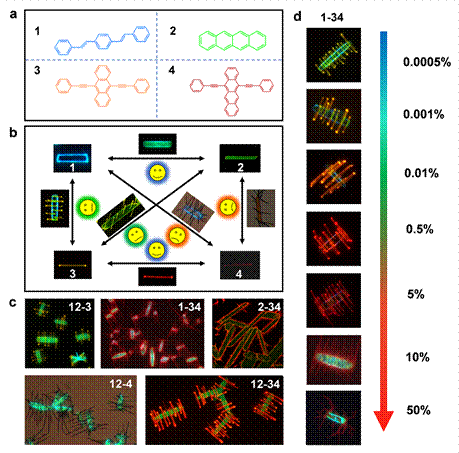Recently, the study on a multi-organic micronae assembly particle bank was reported in the Nature Communications by Professor Lei Yilong and his co-researchers from Tianjin University’s School of Science. Zhang Dandan, a postgraduate student, is the first author of the thesis.

Depending on the compatible components, binary metal mixtures usually exist in the form of alloys or phase separations. The use of metal alloys can even be traced back to the Bronze Age three thousand years ago, and the rapid development of nanoscience in recent years has injected new vitality into traditional polymetallic alloys. Polymetallic nanostructures are now widely used in catalysis, plasma, bioimaging and other fields. Up to now, a major breakthrough has been made in the controlled construction of multimetallic nanoparticle reservoirs of up to five or even eight kinds. Inspired by multimetallic nanoparticles, the researchers hope to integrate multiple organic conjugate molecules into a single nanoparticle. Considering the diversity of organic semiconductor materials and the specific dynamic assembly of different components, it is still a great challenge to synthesize such a diverse variety of complex organic assembly particles. Fortunately, binary organic semiconductor mixtures have been systematically studied and mostly exist in the form of cocrystalline, alloy, or phase-separated heterogeneity. Therefore, the phase behavior and growth sequence of these binary components can be clearly revealed by microscopic real-time imaging.

Figure 1. Four molecular structures with units and micron particles combining units and units, binary, binary and four.
Based on the phase behavior of the binary mixture, the components used to form the alloy can be regarded as fully compatible, while the components used to construct the heterogeneic structure of the ordered orientation can be regarded as partial compatible. In addition, the parts used to construct disordered heterogeneity knots are considered weakly compatible. The compatibleness of binary components is determined by the molecular shape, size and symmetry between the two components. To achieve this, the team cleverly selected four conjugate components of diphenyl benzene, diphenyls , 9,10-diphenyls and 5,12-diphenyls as model compounds for the first time to construct a microparticle library of arbitrary combinations of four components.
Based on real-time imaging information assembled by two components, it is proved that the binary combinations 1/2 and 3/4 are fully compatible, and that 1/3 and 2/3 are compatible. The remaining two binary combinations of 1/4 and 2/4 show weak compatibleness.
Thanks to the assembly information of binary micron particles, the researchers realized the precise regulation of the components, orientation and luminous color of binary and four micron particles. This result provides an ideal example for rational construction of organic microna assemblies of more thantrigram.
In the past three years the research team has published a number of research papers around the concept of multi-organic alloys.




